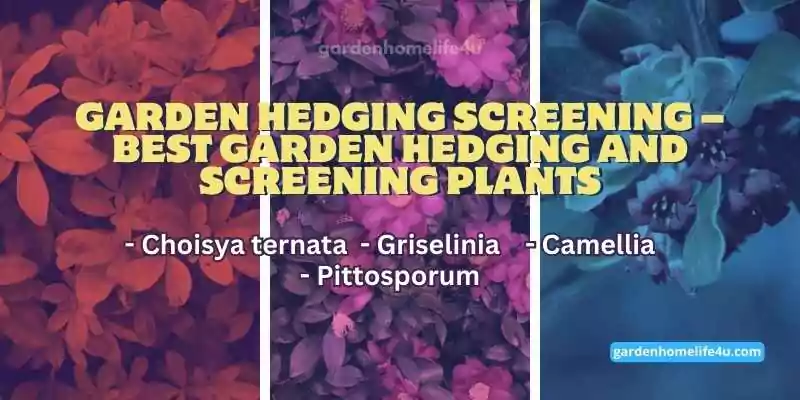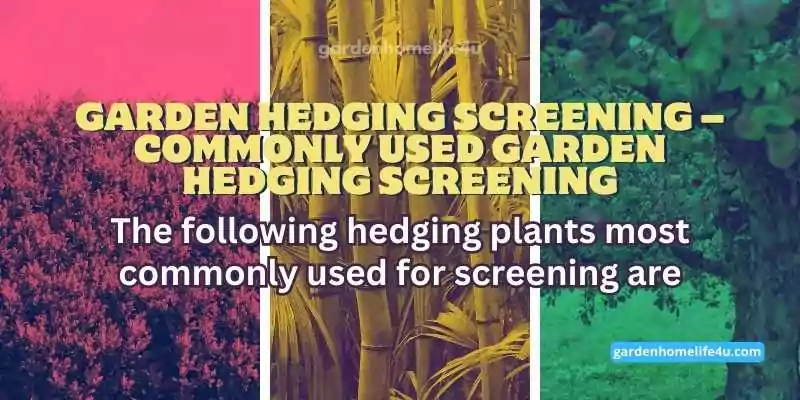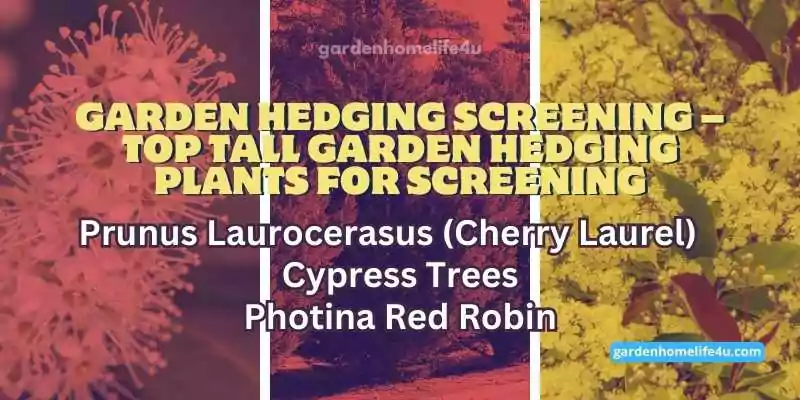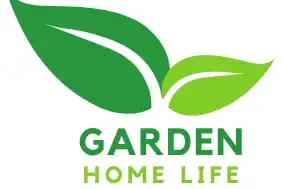In the embrace of our gardens, where serenity meets nature’s symphony, lies the concept of living privacy screens—a seamless blend of lush greenery and purposeful boundaries. Welcome to “Living Privacy Screens – Top Picks for the Best Hedging and Screening Plants,” an exploration into the world of hedging plants that not only adorn our landscapes with beauty but also provide an invaluable sense of seclusion and tranquility.
In this guide, we embark on a journey of creating living barriers that define our outdoor spaces with grace. Each hedging and screening plant presented here is carefully chosen for its ability to thrive in forming natural privacy screens, shielding our gardens from prying eyes, and creating secluded retreats. “Top Picks for the Best Hedging and Screening Plants” unveils a selection of green wonders that serve as living privacy screens, weaving a tapestry of foliage and flowers to offer both visual appeal and practical utility. These living barriers not only contribute to the aesthetics of our landscapes but also foster a deeper connection with nature.
Our guide sheds light on the diverse world of hedging and screening plants, offering a range of options to cater to various garden styles and preferences. From evergreen plants that stand steadfast throughout the seasons to flowering varieties that infuse colors into our secluded havens, each pick adds its unique charm to your outdoor sanctuary.
Moreover, “Living Privacy Screens” extend beyond practicality, creating an environment of tranquility and relaxation. As the rustling leaves and gentle blooms sway in the breeze, a sense of calm and serenity envelop the outdoor spaces, inviting moments of mindfulness and connection with the natural world.
Historically and traditionally, Plants have been utilized to provide garden hedging and screening to cover, provide security, block off unpleasant views, establish borders, and divide areas.
When used for garden screening, garden hedging, or as a partition/border, hedges can be much more attractive and softer than fencing and also more durable. They will, however, take up more space and will require pruning or cutting regularly, at least twice a year if not more.
Plants have long been utilized to provide cover, provide security, block off unpleasant views, establish borders, and divide areas. Hedges are far more beautiful and softer than fences when used for screening or as a partition/border, and they are also more lasting. They will, however, take up more space and will require pruning or cutting regularly, at least twice a year if not more.
Hedges are not only beautiful, but they also help to reduce the impacts of wind by allowing some air to pass through while slowing the airflow. A sturdy fence, on the other hand, will simply buffet the wind over the top.
Garden hedging screening – Deciduous Hedging
The beauty of deciduous hedging is the variation in color scheme throughout the year. For example, when the leaves emerge in the spring, a beech hedge has a fresh green glow, developing to a lovely deep green over the summer months. The beech hedge is at its finest near the end of the year, with magnificent autumnal colors, and once the leaves have fallen, the winter hedge has its own charm.
Garden hedging screening – Evergreen Hedging

Evergreens make excellent hedges, with the added benefit of providing shelter or protection all year. They do, however, require more attention and should be trimmed at least twice a year. Conifers are popular evergreen options, but they must be trimmed on a regular basis since neglected or overgrown conifer hedges (with the exception of yew) cannot be recovered.
Garden hedging screening – Pyracantha Hedging
Pyracantha hedging, commonly known as Firethorn (from the Greek words), attracts a variety of animals in our area. Pyracanthas, with their evergreen foliage and thorny branches, provide deep shelter for birds and hedgehogs alike, making it a suitable habitat for both. Pyracantha’s bright, swollen berries are a rich source of food for a variety of birds, while bees and butterflies frequent the corymbs of white summer flowers. Pyracantha hedging is a wonderful choice for creating a wildlife-friendly landscape, however, our winged guests may be choosy and will consume the berries in order of color preference, red first, sepia second, and so on.
Garden hedging screening – Security Hedging Plants
Using the armory of defense produced by nature over many years in the shape of thorns prickly plants is one of the greatest methods to keep robbers away. A prickly hedge provides year-round protection, whether on a boundary or near to a property, with its very unpleasant tendency of being difficult to push through or climb over. Suitable security hedge plants with wicked thorns, scratching and piercing flesh, or sharply pointed leaves are frequently adequate to prevent thieves and intruders while remaining visually pleasing to people around – and they will be considerably less expensive and endure longer than a fence!
Garden hedging screening – Best Garden Hedging and Screening Plants

Choisya ternata
In late spring and early summer, this plant quickly develops an attractive blooming hedge with glossy leaves and white, pleasantly fragrant flowers. This attractive hedge plant thrives in both the sun and the shade, as well as in a variety of soils.
Griselinia
Griselinia is an excellent choice if you want a brighter hedge. It is a brilliant evergreen with rounded, leathery leaves on climbing stems of yellow-green. It spreads fast to form a thick hedge. Griselinia dislikes the extreme cold and alkaline soil, yet it thrives in coastal gardens and is wind resistant.
Camellia
These blooming beauties can be utilized to create a low or high-maintenance informal or formal hedge. The hedge plants may be grown in the sun or the shade, but they must be planted in soil that is free of lime.
Pittosporum
Pittosporum Tobira, with its wonderfully fragrant blooms, ‘Tom Thumb,’ with its purple foliage, and ‘Irene Paterson,’ with its silvery leaves, all form attractive, evergreen hedges. Late summer or autumn is the best time to shape them.
Carpinus
A fantastic formal hedge plant that grows quickly and easily. Tolerates a wide range of soils, sun, and shade, as well as exposed locations. It has a nice golden fall color and brown foliage in the winter.
Ilex Crenata
This shrub, which is sometimes referred to as a box alternative, has a variety of habits ranging from erect to branching and can be difficult to grow. This hedge plant prefers acidic, well-drained soils and full sun, but may tolerate partial shade.
Planting tall plants to create screening is one of the finest methods to give your garden division and privacy. Fast-growing screening plants provide height to your garden, maybe grown alongside an existing fence to deter intruders, and, of course, provide much-needed solitude, which is perhaps the most frequent reason for planting screening plants.
Garden hedging screening – Commonly Used Garden Hedging Screening

The following hedging plants most commonly used for screening are:
- Hedges
- Bamboo
- Standard trees
- Pleached trees
- Living screens
However, the best garden hedging and screening option will differ depending on the circumstances. It’s crucial to establish what you need your plants to accomplish before diving into more extensive choices.
When selecting extensive choices, the following are the essential questions to consider:
- Do you want your trees to be evergreen or deciduous?
- What are the most important views/locations that need to be assessed?
- What’s the ultimate size does the plant required?
- How long am I willing to wait for total privacy?
- What is the area’s aspect, as well as the soil conditions?
- What additional plant characteristics, such as form and color, I would love to see?
- Do I have a preferred plant choice?
After you’ve settled on these points, you may think about things like:
- Viewpoint suitability
- Flower and smell
- Wildlife friendliness
- Preferred season of interest
- Leaf form and texture
Garden hedging screening – Top Tall Garden Hedging Plants for Screening

- Prunus Laurocerasus (Cherry Laurel)
- Cypress Trees
- Photina Red Robin
- Fargesia Murielae Bamboo
- Magnolia grandiflora
- Dogwood (Cornus)
- Elaeagnus x ebbingei (Silverberry)
- Ceanothus Concha (California Lilac)
Prunus Laurocerasus (Cherry Laurel)
Cherry Laurel is a wide, spreading shrub with long, dark green leaves that can grow up to 15cm in length. The blooms produced have a beautiful range of colors and a rich plum smell. The flowers appear on stems in the middle of summer and finally, give way to crimson fruits that turn purple-black in the autumn. This fast-growing shrub is an excellent choice for privacy screens or other garden screenings. The plant prefers full sun or light shade, as well as well-drained soil. After the flowers have bloomed, you can trim them, but other than that, it requires very little attention. This creates an amazing screen.
Silverberry
This plant thrives in sandy loamy soil and may be grown in full sun or moderate shade. It can withstand drought once established, making it a good choice for coastal regions. As a fast-growing shrub, it may be planted in infertile soil as long as there is adequate drainage. Their scales are green and silver in color. These fragrant blooms herald the arrival of tiny red/brown fruits.
Cypress Trees
Cypress trees come in a wide range of kinds, over 130 to be exact, so there’s certain to be something suitable for your landscape. The leaves are silvery-green to dark green. They grow in spirals or whorled patterns and can withstand almost any soil type.
Photina Red Robin
It produces white flowers that are spectacular and fragrant in the early spring. It thrives on medium-moisture, well-drained soil and may be found in partial shade to full sun. It may also be cultivated in full shade, however, the floriferous characteristics will be compromised. When the red growth begins to fade in the spring, you may trim it to thin it down and improve air circulation, particularly in the winter. This plant is known for its rapid growth and red tops/tips, which contrast nicely with the evergreen color.
California Lilac
This plant is a great screening plant and will offer something special to your yard. If you want a vibrant screen, these flowers’ deep violet blues and purples will do the trick. They are magnificent from a distance, with what looks to be an abundance of flowers. They are even more beautiful when viewed up close.
Fargesia Murielae Bamboo
Because of its shape and design, this bamboo variety is known as umbrella bamboo. It grows to a height of 4 meters and produces densely packed bamboo stems. This bamboo has dense leaves, prefers partial shade, and can withstand the worst circumstances to which bamboo may be subjected.
Magnolia grandiflora
This magnolia species is regarded as one of the hardiest, especially in harsh winter conditions. It’s a tree that can grow to be up to 25 meters tall. It thrives in full sun or light shade and requires moderate watering. The tree is most renowned for its fragrant and beautiful blooms, which bloom in white between May and June. This tree has beautiful dark green foliage and big white flowers that emerge in the spring and continue throughout the summer.
Dogwood (Cornus)
Dogwood, which is both a tree and a shrub, is noted for its beautiful white or pink flower bracts and low maintenance requirements. Dogwoods grow at a rapid rate, reaching a height of 30cm or more per year. As a result, a single tree can reach full maturity in less than a decade. The petal-like bracts of flowers come in a variety of colors, including light pink, brilliant pink, and white.
Our Selection: Fast-growing Shrubs for Screening purpose
If you are a household and taking privacy while enjoying your time in the backyard then look no further than burning some quick-growing shrubs. These shrubs are fast-growing hence they could grow out of control rather if left unchecked. Obviously, pruning is the answer to all growth challenges and some may need annual and others semi-annual sessions. A privacy hedge height will depend on regulation however most areas’ regulation is 6 to 8 feet. This is also a factor to keep in mind while planning to buy shrubs for screening.
BeautyBerry
This one is a fast grower but has wonderfully beautiful purple flowers and is up to 3 meters in height. Pruning is recommended frequently to keep the growth in check.
Arborvitae
This wonder even green shrub or trees has many subspecies and they don’t always follow the same growth rate rules so be careful what you choose for your application of privacy screens. If you are after a large and even green privacy screen then Green Giant Arborvitae could be a good selection. They could reach up to 50 to 60 feet in height which sounds awesome but is not suited for all privacy screen applications. If you are looking for something more manageable and compact then Emerald Green Arborvitae is a very good pick as it grows up to 14 feet and does not spread more than 5 feet wide.
Mock Orange Shrub
this is a wonderfully fragrant shrub and as the name kind of hints, rather, unfortunately, it is named in a rather funny ironic way as a mock color which it does not carry. It is not actually orange but the smell is enough citrus to suggest that it is a circus or orange plant.
Canadian Hemlock
This is not the notorious poisonous killer Hemlock plant as you would confuse with the name, it is the gentle counterpart that forms very nice privacy screens. This can be a tree if left unchecked but when growth is controlled this fast grower can form very good-looking and dense lush green privacy screens.
Cherry Laurell
This is again our favorite pick. This wonderful evergreen shrub has beautiful shiny leaves which do not shed or change colors during winter. This is ideal for people who are looking for evergreen dense foliage cosmetic privacy screens.
Leylandii
This is a fast grower and very commonly seen screening plant which can reach massive heights. Its aggressive nature can result in this growing up to 5 feet a year. It has a certain bad reputation but if you can keep up with regular pruning regimes then it is a wonderful and thick, hard-to-get-through, functional privacy screen.
Yew
This evergreen shrub will not mind growing on a north-facing setup which can be a huge advantage in certain situations.
Burning Bush
This one is a fast grower with exciting autumn colors that would outperform any other bush in the garden. The only issue is its capacity for being invasive to a high degree so be careful when choosing it.
The Closure,
Soil preparation is critical for each plant you want to grow. Add a slow-release fertilizer and a lot of garden compost or shrub and tree planting compost. After planting, make sure to water well. During the initial growing season, it’s critical to keep the plants well-watered. Find plants that you like and that need just the appropriate amount of care. Check out these cool ideas for your garden if get the chance.

